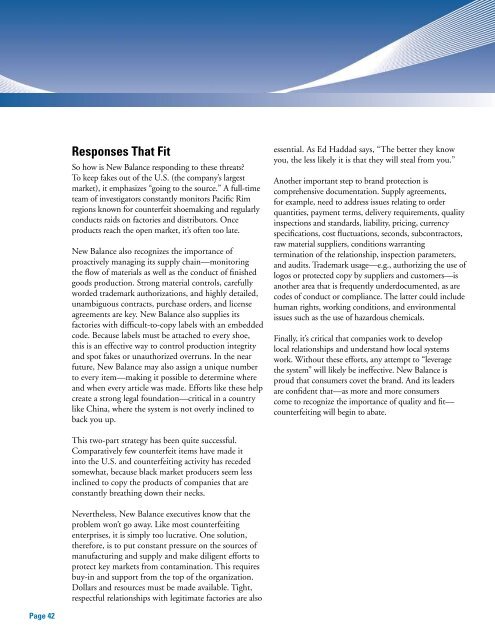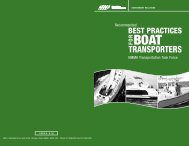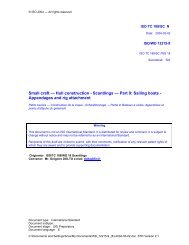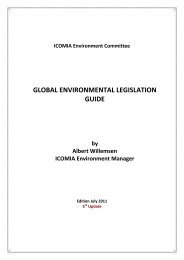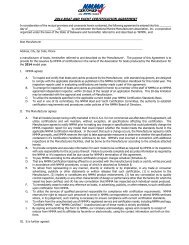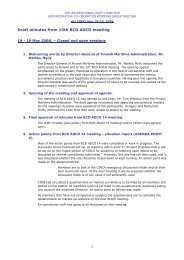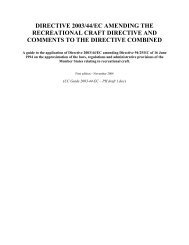Intellectual Property Protection and Enforcement Manual - Ipr-policy.eu
Intellectual Property Protection and Enforcement Manual - Ipr-policy.eu
Intellectual Property Protection and Enforcement Manual - Ipr-policy.eu
Create successful ePaper yourself
Turn your PDF publications into a flip-book with our unique Google optimized e-Paper software.
Responses That Fit<br />
So how is New Balance responding to these threats<br />
To keep fakes out of the U.S. (the company’s largest<br />
market), it emphasizes “going to the source.” A full-time<br />
team of investigators constantly monitors Pacific Rim<br />
regions known for counterfeit shoemaking <strong>and</strong> regularly<br />
conducts raids on factories <strong>and</strong> distributors. Once<br />
products reach the open market, it’s often too late.<br />
New Balance also recognizes the importance of<br />
proactively managing its supply chain—monitoring<br />
the flow of materials as well as the conduct of finished<br />
goods production. Strong material controls, carefully<br />
worded trademark authorizations, <strong>and</strong> highly detailed,<br />
unambiguous contracts, purchase orders, <strong>and</strong> license<br />
agreements are key. New Balance also supplies its<br />
factories with difficult-to-copy labels with an embedded<br />
code. Because labels must be attached to every shoe,<br />
this is an effective way to control production integrity<br />
<strong>and</strong> spot fakes or unauthorized overruns. In the near<br />
future, New Balance may also assign a unique number<br />
to every item—making it possible to determine where<br />
<strong>and</strong> when every article was made. Efforts like these help<br />
create a strong legal foundation—critical in a country<br />
like China, where the system is not overly inclined to<br />
back you up.<br />
essential. As Ed Haddad says, “The better they know<br />
you, the less likely it is that they will steal from you.”<br />
Another important step to br<strong>and</strong> protection is<br />
comprehensive documentation. Supply agreements,<br />
for example, need to address issues relating to order<br />
quantities, payment terms, delivery requirements, quality<br />
inspections <strong>and</strong> st<strong>and</strong>ards, liability, pricing, currency<br />
specifications, cost fluctuations, seconds, subcontractors,<br />
raw material suppliers, conditions warranting<br />
termination of the relationship, inspection parameters,<br />
<strong>and</strong> audits. Trademark usage—e.g., authorizing the use of<br />
logos or protected copy by suppliers <strong>and</strong> customers—is<br />
another area that is frequently underdocumented, as are<br />
codes of conduct or compliance. The latter could include<br />
human rights, working conditions, <strong>and</strong> environmental<br />
issues such as the use of hazardous chemicals.<br />
Finally, it’s critical that companies work to develop<br />
local relationships <strong>and</strong> underst<strong>and</strong> how local systems<br />
work. Without these efforts, any attempt to “leverage<br />
the system” will likely be ineffective. New Balance is<br />
proud that consumers covet the br<strong>and</strong>. And its leaders<br />
are confident that—as more <strong>and</strong> more consumers<br />
come to recognize the importance of quality <strong>and</strong> fit—<br />
counterfeiting will begin to abate.<br />
This two-part strategy has been quite successful.<br />
Comparatively few counterfeit items have made it<br />
into the U.S. <strong>and</strong> counterfeiting activity has receded<br />
somewhat, because black market producers seem less<br />
inclined to copy the products of companies that are<br />
constantly breathing down their necks.<br />
Nevertheless, New Balance executives know that the<br />
problem won’t go away. Like most counterfeiting<br />
enterprises, it is simply too lucrative. One solution,<br />
therefore, is to put constant pressure on the sources of<br />
manufacturing <strong>and</strong> supply <strong>and</strong> make diligent efforts to<br />
protect key markets from contamination. This requires<br />
buy-in <strong>and</strong> support from the top of the organization.<br />
Dollars <strong>and</strong> resources must be made available. Tight,<br />
respectful relationships with legitimate factories are also<br />
Page 42


